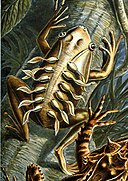Файл:Haeckel Batrachia.jpg
Перейти до навігації
Перейти до пошуку

Розмір при попередньому перегляді: 424 × 599 пікселів. Інші роздільності: 170 × 240 пікселів | 339 × 480 пікселів | 543 × 768 пікселів | 724 × 1024 пікселів | 2323 × 3284 пікселів.
Повна роздільність (2323 × 3284 пікселів, розмір файлу: 2,17 МБ, MIME-тип: image/jpeg)
Історія файлу
Клацніть на дату/час, щоб переглянути, як тоді виглядав файл.
| Дата/час | Мініатюра | Розмір об'єкта | Користувач | Коментар | |
|---|---|---|---|---|---|
| поточний | 03:17, 24 лютого 2006 |  | 2323 × 3284 (2,17 МБ) | Ragesoss | improve version, based on same original scan |
| 00:22, 11 лютого 2006 |  | 2318 × 3280 (2,21 МБ) | Ragesoss | The 68th plate from Ernst Haeckel's 1899 ''Kunstformen der Natur'', depicting frogs classified as Batrachia. Category:Ernst Haeckel |
Використання файлу
Така сторінка використовує цей файл:
Глобальне використання файлу
Цей файл використовують такі інші вікі:
- Використання в arz.wikipedia.org
- Використання в ast.wikipedia.org
- Використання в az.wikipedia.org
- Використання в ban.wikipedia.org
- Використання в be.wikipedia.org
- Використання в bg.wikipedia.org
- Використання в ca.wikipedia.org
- Використання в ca.wikibooks.org
- Використання в ceb.wikipedia.org
- Використання в ckb.wikipedia.org
- Використання в dag.wikipedia.org
- Використання в de.wikipedia.org
- Використання в din.wikipedia.org
- Використання в el.wikipedia.org
- Використання в en.wikipedia.org
- Wikipedia:Featured pictures thumbs/04
- Wikipedia:Picture of the day/June 2006
- User:Ragesoss/Haeckel
- Wikipedia:Featured picture candidates/Haeckel Batrachia.jpg
- Wikipedia:Wikipedia Signpost/2006-03-13/Features and admins
- Wikipedia:Featured picture candidates/March-2006
- Talk:Frog/Archive 3
- User talk:Ragesoss/Archive1
- Wikipedia:Picture of the day/June 12, 2006
- Wikipedia:POTD/June 12, 2006
- Wikipedia:POTD column/June 12, 2006
- Wikipedia:POTD row/June 12, 2006
- Kunstformen der Natur
- User:Samsara/Frog/Stable
- User:RichardF/POTD
- Wikipedia:WikiProject Germany/Gallery
- User talk:RichardF
- User:Froggyyes~enwiki
- Wikipedia:Featured pictures/Animals/Amphibians
- Unclean spirit
- User:Xophist/s5
- Wikipedia:Wikipedia Signpost/2006-03-13/SPV
- Portal:Amphibians
- Talk:Alfred Russel Wallace/Archive 1
- Portal:Amphibians/Selected picture
Переглянути сторінку глобального використання цього файлу.






